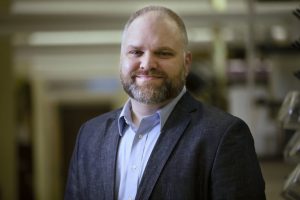An interdisciplinary research working group on space biology formed by NASA has transformed into the Coronavirus International Research Team, which includes Jonathan Schisler, PhD, at the UNC School of Medicine.

An interdisciplinary research working group formed by NASA scientist Afshin Behesti to address space biology through the lens of data science has transformed to become the Coronavirus International Research Team. Comprised of biologists, virologists, epidemiologists, and technologists, the group — which includes more than 100 researchers across 31 institutions — is sharing data to explore how the coronavirus functions in the body.
Using recently released public data, multiple researchers within the group, including UNC biochemist and age researcher Jonathan Schisler, PhD, assistant professor of pharmacology at UNC, are studying the molecular signatures of respiratory cells found in COVID-19 patients. Through their independent analyses, a common theme emerged: Genes that are important for mitochondria to function are affected by the virus. Mitochondria are the energy generators for our cells, and that loss of energy results in cell death. It seems that the mitochondria may be a casualty of the viral infection — resulting in massive amounts of cell destruction within the lungs of COVID-19 patients.
Within a cell, RNA acts as a template for creating proteins in order to build and repair tissues in the body. MicroRNA regulates that production by binding to RNA and preventing it from producing additional proteins. It’s possible the virus may be hijacking microRNAs to promote its replication in the lung cells of patients, Schisler says. As a consequence, the lung cells are left with little ability to generate energy.
While access to additional lung cell samples is currently limited, COVID-19 testing is predominantly done with nasopharyngeal swabs. The team is conducting studies on cells extracted from the swabs of hundreds of COVID-19-positive patients. Schisler is using that data to study how age affects the RNA signature in these cells and impacts viral response.
Nationally, as of April, people ages 65 and above are experiencing the highest rates of death and hospitalization for COVID-19, according to the Centers for Disease Control and Prevention.
As we age, our bodies are less adaptable to changes in cellular energy. This means people who are 65 and older may struggle to regenerate proteins needed for mitochondria to work properly. Add a coronavirus to that equation, and their cells are even more at risk for an energy crisis. Schisler and the research team believe that mitochondrial failure causes the cell destruction that leads to the primary cause of death among COVID-19 patients: respiratory failure.
“It’s possible that older people may be more susceptible because they are less flexible to changes in how cells maintain their energy production,” Schisler says.
Schisler has studied aging among North Carolinians by analyzing their blood plasma, the liquid part of the blood that carries cells and proteins throughout the body. Now, he’s tapping into those data sets to study how microRNA levels not only change as people age but differ across demographics like smokers and African Americans.
“To paint the full picture, we have to figure out how these specific microRNAs implicated in COVID-19 differ in healthy people across age groups, sexes, and races as we try to figure out how they work in people who have the virus,” Schisler says.
Since Schisler and the entire Coronavirus International Research Team believe microRNA are playing such a large role in patients with COVID-19, they have teamed up with therapeutics company AUM LifeTech to develop an antiviral therapy that inhibits microRNA production. So far, AUM LifeTech has committed $500,000 to produce a potential treatment for the virus.
“I don’t think I’ve ever been a part of so much selfless science,” Schisler says. “Everyone is sharing their data, and it makes me feel awesome to be a scientist. There’s so much red tape in academia, and the fact that we’re going from nothing to this in one month is pretty remarkable.”
Schisler holds a joint faculty appointment in the Department of Pathology and Laboratory Medicine and is a member of the UNC McAllister Heart Institute.
Written by Alyssa LaFaro at the UNC Chapel Hill Office of Research Communications.